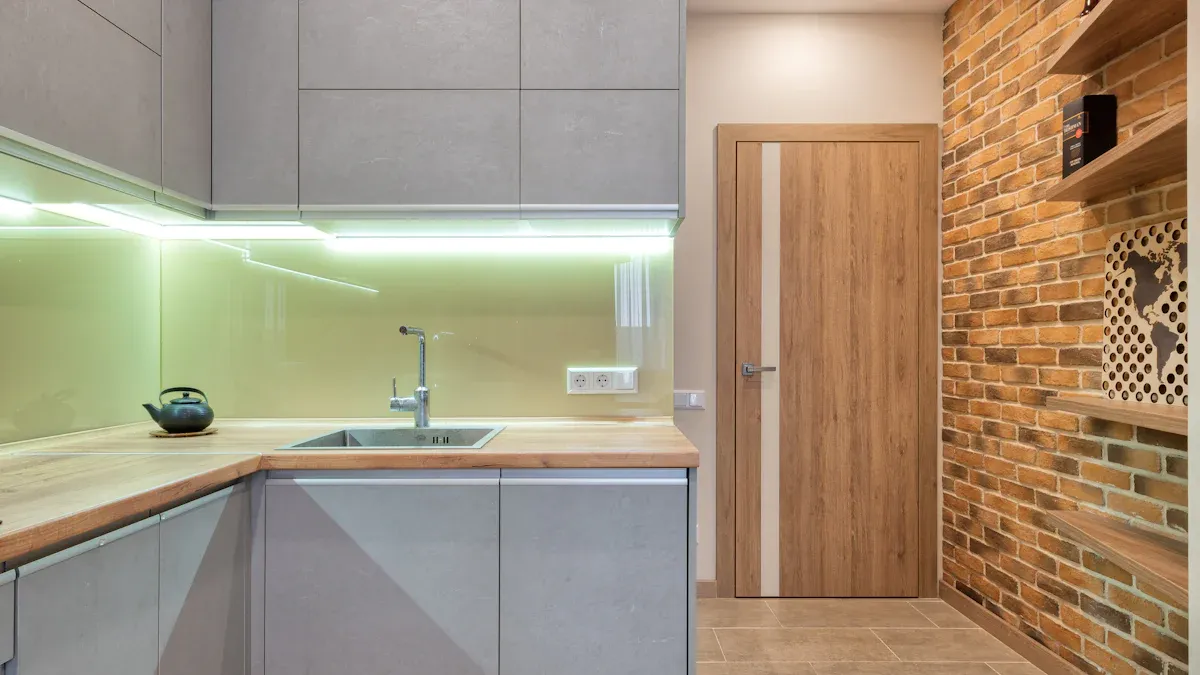
When I switched to LED under cabinet light in my kitchen, I noticed a big difference right away. The light felt brighter and more focused. Cooking became easier, and I didn’t worry about heat or high energy bills. Good lighting really changes how a kitchen feels.
Key Takeaways
- LED under cabinet lights shine brighter and use less energy than traditional bulbs, making kitchen tasks easier and saving money on bills.
- LED lights last much longer and stay cool, reducing maintenance and safety worries compared to halogen or fluorescent options.
- Installing LEDs is flexible and simple, with options for warm or cool light to match your kitchen style and improve its look and feel.
Under Cabinet Light Brightness and Quality
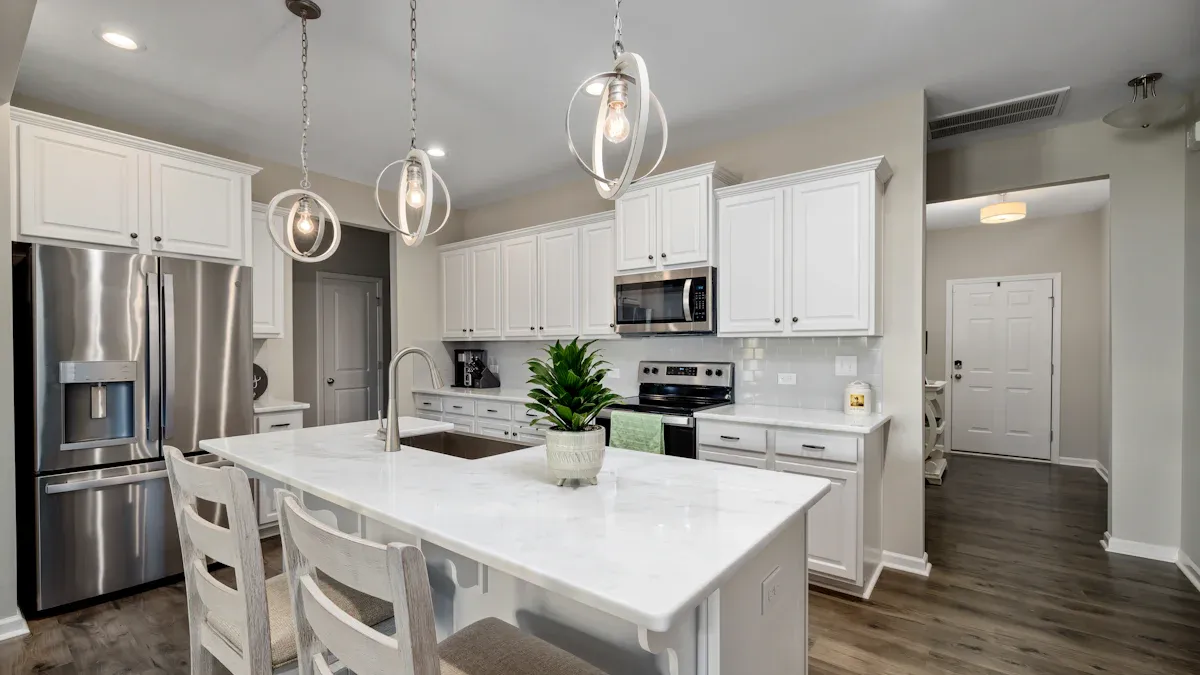
LED Brightness and Color Options
When I first installed LED under cabinet lights, I noticed how bright and clear my kitchen became. LEDs stand out because they deliver a lot of light without using much power. Here’s a quick look at how LEDs compare to traditional options:
| Lighting Type | Typical Wattage Range | Lumens per Watt (Efficiency) | Typical Lumen Output per Fixture |
|---|---|---|---|
| LED | 4-10 watts | 80-100 lm/W | 320-1000 lumens |
| Fluorescent | 8-20 watts | 50-70 lm/W | 400-1400 lumens |
| Xenon | 15-25 watts | 15-20 lm/W | 225-500 lumens |
| Halogen | 20-50 watts | 10-20 lm/W | 200-1000 lumens |
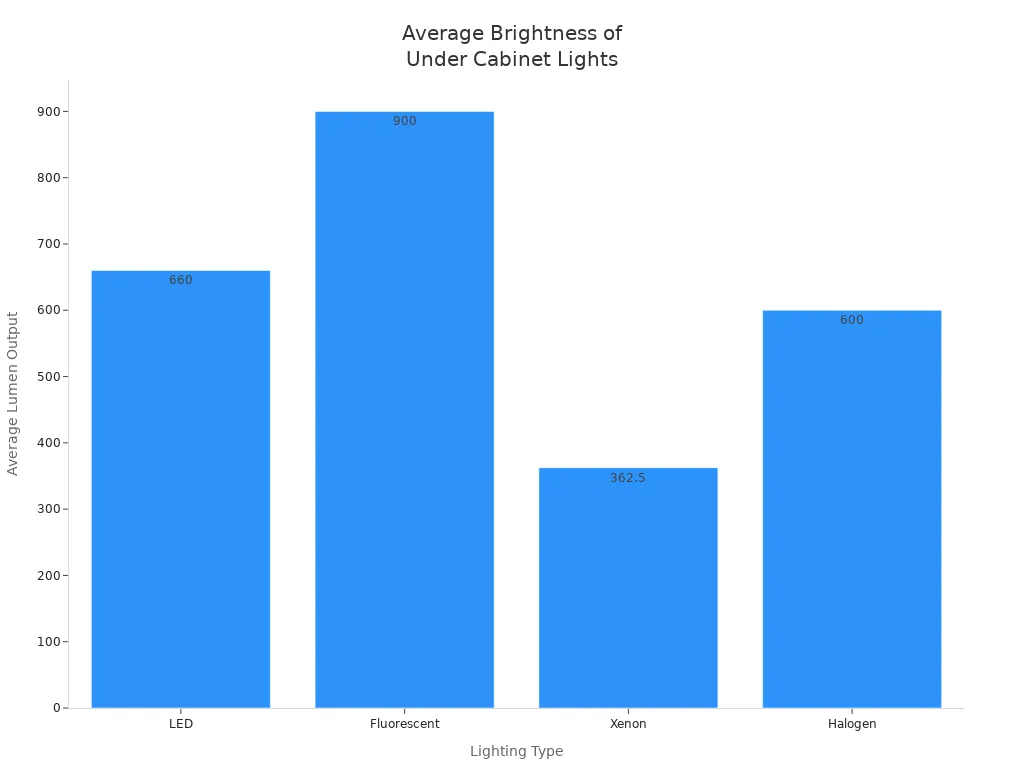
I love that LEDs come in different color temperatures. If you want a cozy, warm feel, you can pick LEDs in the 2700K-3000K range. These give off a soft, yellowish light, perfect for relaxing or family dinners. For a brighter, more modern look, cool white LEDs (4000K-5000K) work great. They make it easier to see what you’re doing, especially when chopping or reading recipes. Some people even mix both warm and cool lights to get the best of both worlds. I found that using cool white LEDs for tasks and warm white for ambiance made my kitchen both functional and inviting.
Tip: If you want your kitchen to look bigger and brighter, try cool white LEDs. For a softer, more welcoming vibe, stick with warm white.
Traditional Under Cabinet Light Brightness
Before switching to LEDs, I used traditional under cabinet lights like fluorescent and halogen bulbs. These lights can get pretty bright, but they use more energy and sometimes feel harsh. Most traditional options provide about 200 to 400 lumens per linear foot, which usually covers basic kitchen needs. Fluorescent bulbs give off a lot of light but can look cold and sometimes flicker. Halogen bulbs offer a light that looks close to daylight, which helps with color accuracy, but they get hot and don’t last as long.
I remember my old halogen lights made my kitchen feel warm—sometimes too warm. They did a good job lighting up the counters, but I had to replace them often. Fluorescent lights lasted longer but didn’t always make my kitchen look its best. The color sometimes made my cabinets look dull.
Practical Comparison in Kitchen Use
When I compare LED and traditional under cabinet lights in real kitchen use, LEDs win for me every time. LEDs give me bright, even light right where I need it. They don’t get hot, so I can prep food without worrying about heat near my hands or food. I also noticed that modern LEDs have a high color rendering index (CRI), often above 90. This means colors look true and vibrant, which is important when checking if food is cooked or when I want my kitchen to look its best.
Here’s a quick table that sums up how LEDs and traditional lights stack up for everyday kitchen tasks:
| Feature | LED Lighting | Xenon Lighting |
|---|---|---|
| Lifespan | Up to 50,000 hours, fewer replacements | Around 10,000 hours, more frequent changes |
| Heat Emission | Minimal, safer near food and cabinetry | Slightly more than LED |
| Color Rendering | Improved CRI, now comparable to xenon | Excellent, ideal for accurate color tasks |
| Energy Efficiency | Uses up to 75% less energy than xenon | Higher energy consumption |
| Maintenance | Low maintenance due to long lifespan | Higher maintenance due to shorter lifespan |
| Cost | Higher upfront, cost-effective long-term | Lower upfront, higher long-term costs |
I find that LEDs make kitchen tasks like chopping, mixing, and reading recipes much easier. The light is focused and doesn’t cast weird shadows. I also don’t have to worry about replacing bulbs all the time. For me, LEDs are the clear winner for under cabinet light in any busy kitchen.
Under Cabinet Light Energy Efficiency
Power Consumption Differences
When I started looking at energy use in my kitchen, I noticed a big gap between LED and traditional lights. LEDs use much less power than older options. Here’s a quick table that shows the difference:
| Lighting Type | Average Wattage Range | Lumens per Watt (Efficiency) |
|---|---|---|
| LED | 4-10 watts | 80-100 lm/W |
| Fluorescent | 8-20 watts | 50-70 lm/W |
| Xenon | 15-25 watts | 15-20 lm/W |
| Halogen | 20-50 watts | 10-20 lm/W |
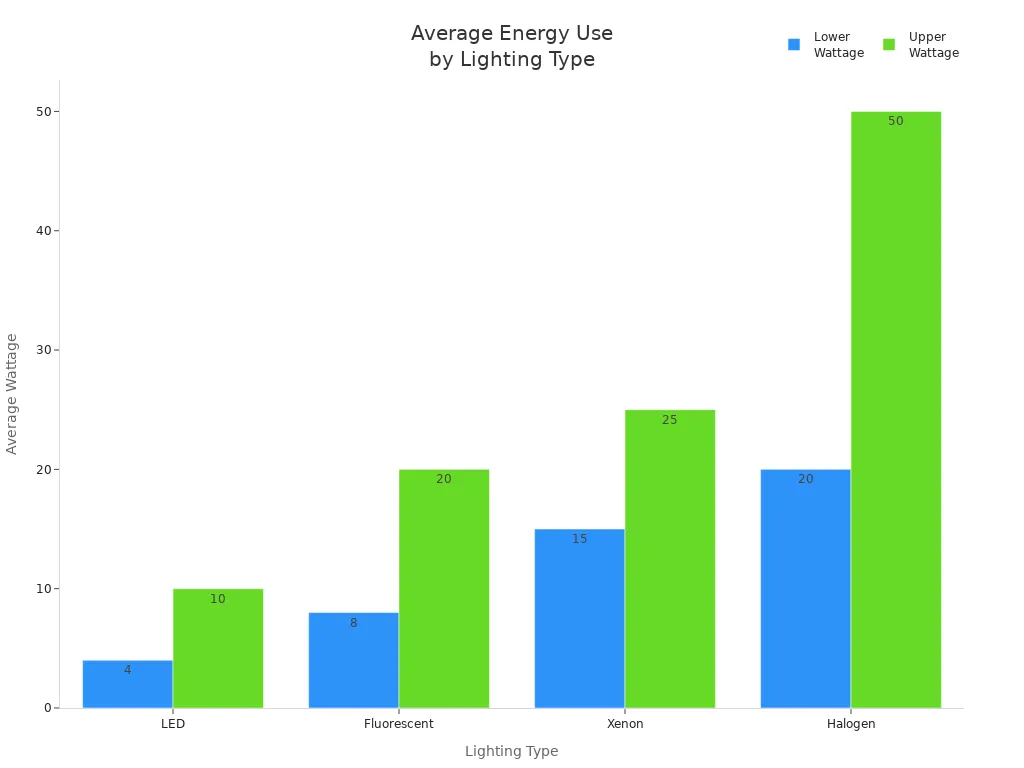
I found that my LED under cabinet light only used about 6 watts per fixture. My old halogen lights used up to 40 watts each! That’s a huge difference. LEDs also give off less heat, so my kitchen stays cooler, and I don’t worry about extra heat near my food.
Impact on Energy Bills
Switching to LEDs made a real impact on my monthly bills. I read that LED lighting can cut lighting energy use by up to 75%. While this number covers the whole house, I still noticed savings in my kitchen. My energy bill dropped, and I didn’t have to replace bulbs as often. Over a year, households can save around $225 just by switching to LEDs for all lighting. Even though under cabinet lights are a small part of the kitchen, every bit helps.
LEDs also last much longer than traditional bulbs. I don’t have to buy new bulbs every few months. This means I save money and time. Plus, using less energy helps the environment. My kitchen feels brighter, my bills are lower, and I know I’m making a smart choice for my home.
Under Cabinet Light Lifespan and Maintenance
LED Lifespan and Durability
When I switched to LED under cabinet light, I noticed I didn’t have to worry about replacing bulbs for years. LEDs last much longer than any traditional bulb I’ve used. Most LED fixtures run for 25,000 to 50,000 hours. That means if I use them for three hours a day, they could last up to 45 years! Here’s a quick table that shows how LEDs stack up against other options:
| Light Type | Average Lifespan (hours) | Notes |
|---|---|---|
| LED Under Cabinet | 25,000 – 50,000 | Can last up to 45 years if used 3 hours/day; longevity influenced by quality and usage |
| Incandescent Bulbs | ~1,000 | Short lifespan, high energy consumption |
| Halogen Bulbs | 2,000 – 4,000 | Slightly longer than incandescent but still much shorter than LEDs |
| Fluorescent Bulbs | 7,000 – 15,000 | More efficient than incandescent and halogen; contain hazardous materials like mercury |
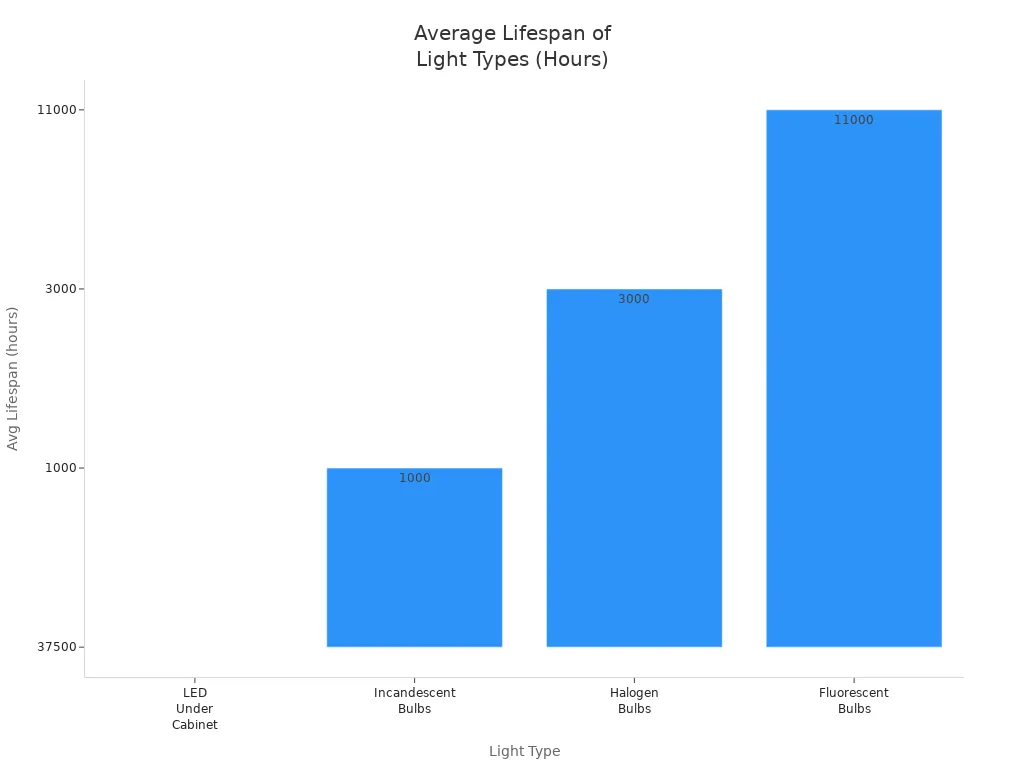
I also like that LEDs don’t just burn out suddenly. They slowly get dimmer over time, so I always know when it’s time for a change.
Traditional Bulb Replacement Frequency
With traditional bulbs, I found myself replacing them way too often. Incandescent bulbs usually last about 1,000 hours. Halogen bulbs might reach 4,000 hours if I’m lucky. Fluorescent bulbs do a bit better, but I still had to keep spare bulbs in the drawer. The short lifespan means more trips to the store and more time spent on maintenance. I also noticed that traditional bulbs can burn out without warning, which always seemed to happen when I needed them most.
Maintenance Considerations
Maintenance for under cabinet lighting can be a hassle if you don’t pick the right system. I’ve run into issues like flickering, buzzing, and even uneven lighting. Sometimes, poor installation or the wrong dimmer switch caused problems with my LEDs. With traditional lights, I dealt with shadows, exposed wires, and complicated wiring. Here are some common issues I’ve faced:
- Flickering or buzzing from incompatible switches
- Dark spots from poor fixture placement
- Inconsistent color temperature
- Frequent bulb changes with traditional lights
- Overheating from bad installation
Tip: I always double-check the compatibility of my dimmer switches and make sure the fixtures are spaced evenly. This helps avoid most headaches down the road.
Under Cabinet Light Heat Emission and Safety
LED Heat Output
When I touch my LED under cabinet light, it feels cool—almost like touching my phone after a call. I never worry about burning my hand or heating up the kitchen. LEDs stay cool because they use energy so efficiently. Even after hours of use, the fixture barely gets warm. This makes a big difference, especially when I’m prepping food right under the light. I’ve learned that LEDs do create a little heat at the chip level, but with the right installation, like using aluminum profiles, that heat gets pulled away fast. In my kitchen, I use these profiles to keep everything running smoothly, even in tight spots with less airflow.
Traditional Light Heat Risks
My old halogen and xenon lights got hot—sometimes too hot to touch. I remember feeling the warmth on my hands while chopping veggies. Traditional bulbs waste a lot of energy as heat. This can make the kitchen uncomfortable, especially in summer. I also worried about the risk of burns or even fire if something flammable got too close. Fluorescent lights don’t get as hot as halogen, but they still warm up the area. I always felt safer after switching to LEDs.
Kitchen Safety Factors
Safety matters most in the kitchen. I want lights that don’t add extra heat or risk. LEDs help me keep my kitchen safer because they stay cool and lower the chance of burns. I also like that they don’t heat up my cabinets or food. For kitchens with little ventilation, I make sure to use aluminum profiles with my LEDs. This setup keeps the lights cool and working longer. I feel confident knowing my under cabinet light won’t cause problems, even in a busy family kitchen.
Under Cabinet Light Cost Comparison
Upfront Costs
When I first shopped for under cabinet lighting, I noticed that LED options cost more up front than traditional lights. For example, a single LED puck light usually costs around $25, while an LED strip for an 8-foot section is about $20. If I wanted to save money, I could buy a DIY LED strip kit for as little as $15, but I learned those might not last as long. Professional installation adds about $200 per fixture, and hiring an electrician can bring the total to $350. Traditional lights, like fluorescent or xenon, often have lower fixture prices, sometimes as low as $12 per unit. However, I realized that these savings don’t always last.
| Lighting Type | Average Fixture Cost | Installation Labor Cost | Additional Materials Cost |
|---|---|---|---|
| LED Puck Lights | Around $25 per fixture | About $200 per fixture | $20 to $25 per light |
| LED Strip Lights | About $20 per 8-foot strip | About $200 per fixture | $20 to $25 per light |
| Xenon Fixtures | Approximately $50 per unit | About $200 per fixture | $20 to $25 per light |
| Fluorescent Lights | $12 to $50 per unit | About $200 per fixture | $20 to $25 per light |
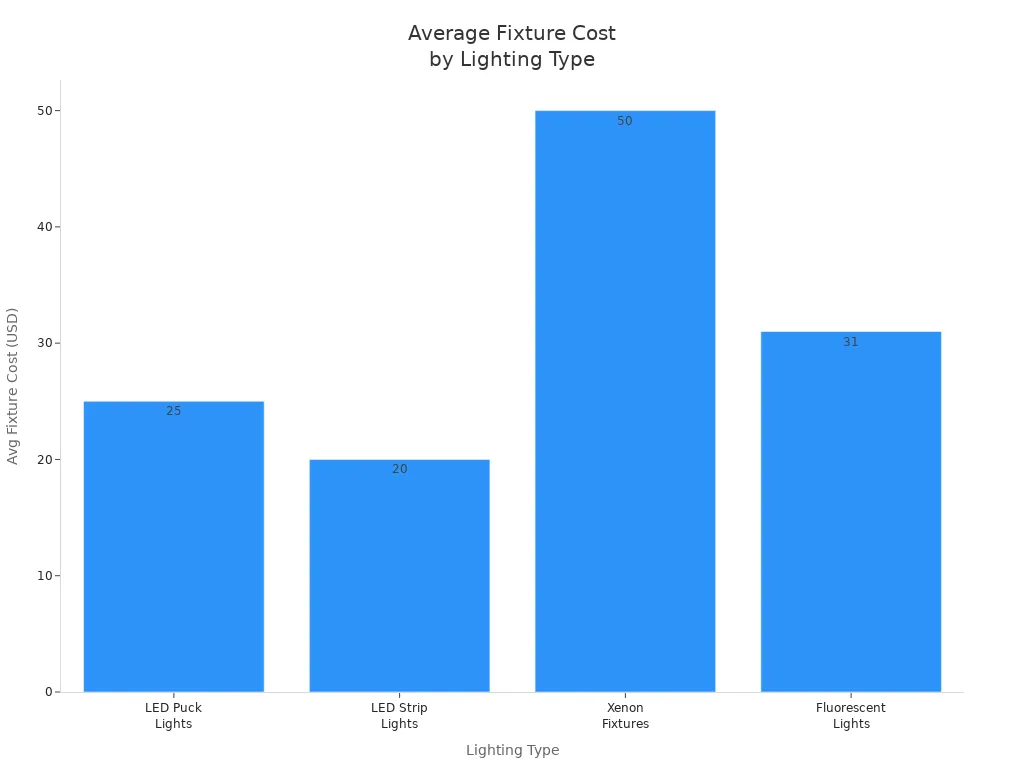
Long-Term Savings
Even though I paid more at the start for LEDs, I quickly saw the savings add up. LEDs use much less energy than traditional bulbs. For the same amount of light, an LED uses about 10 watts, while an old incandescent bulb uses 60 watts. My monthly energy cost for one LED bulb is only about 20 cents if I use it five hours a day. The same use with a traditional bulb costs over a dollar. That difference adds up every month.
| Aspect | LED Lighting | Traditional Lighting (Incandescent) |
|---|---|---|
| Energy Efficiency | Converts 90-95% of electricity into light | Converts about 10-15% of electricity into light |
| Energy Consumption | ~10 watts for equivalent light output | ~60 watts for equivalent light output |
| Lifespan | 25,000 to 50,000 hours | About 1,000 hours |
| Maintenance | Much lower due to long lifespan | Higher due to frequent replacements |
| Monthly Energy Cost | Approximately $0.195 per bulb (5 hrs/day) | Approximately $1.17 per bulb (5 hrs/day) |
| Total Cost of Ownership | Lower over time due to energy and maintenance savings | Higher due to energy use and frequent replacements |
LEDs also last up to 50 times longer than traditional bulbs. I don’t have to replace them often, which saves me time and money. I found that the payback period for switching to LED under cabinet light is usually about five years, and sometimes less if I get a rebate. Over time, the savings really shine.
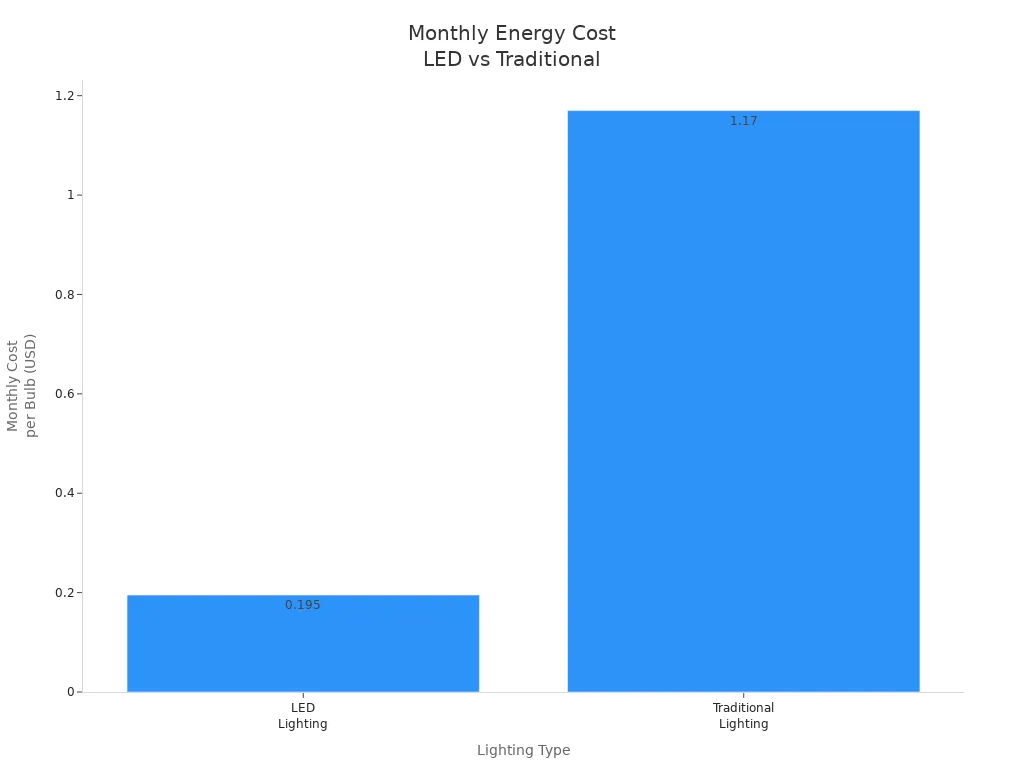
Under Cabinet Light Installation and Flexibility
Installing LED Under Cabinet Lights
When I installed my first LED under cabinet light, I thought it would be easy. I quickly learned that a few things can trip you up. Here are the most common challenges I faced:
- Measuring the cabinets and planning the placement took time. I wanted to avoid shadows and make sure the light hit the right spots.
- Mounting the lights needed the right hardware. I used adhesive strips for LED strips and brackets for puck lights. I double-checked the alignment so everything looked neat.
- Wiring was tricky. I always turned off the power before starting. Loose connections or a tripped breaker can cause problems, so I followed the instructions closely.
- Picking the right color temperature made a big difference. Warm light felt cozy, but cool light helped me see better when cooking.
- I tried different angles and sometimes added extra fixtures to get rid of dark spots.
Tip: If you want dimming features, make sure your dimmer switch matches your LED lights. This helps you control the mood and save energy.
Installing Traditional Under Cabinet Lights
I remember installing traditional lights like fluorescent or xenon. The process felt more complicated. I had to deal with bulkier fixtures and more wiring. Sometimes, I needed to drill holes for mounting. Traditional lights often required hardwiring, which meant I had to call an electrician. I also worried about heat, especially with halogen bulbs. Replacing bulbs was a regular chore, and I had to be careful with glass tubes or hot surfaces.
Adaptability for Different Kitchen Layouts
LED under cabinet lighting changed how I think about kitchen design. I can use strip lights for long counters or puck lights for small spaces. The adhesive backing makes installation simple, even in tight corners. I can adjust the color temperature and brightness to match my kitchen’s style. LEDs stay cool and last for years, so I don’t worry about heat or frequent replacements. Traditional lights just don’t offer this kind of flexibility. They use more energy, get hotter, and don’t always fit odd-shaped cabinets. For me, LEDs make it easy to light any kitchen layout, whether it’s modern, classic, or somewhere in between.
Real-Life Under Cabinet Light Scenarios
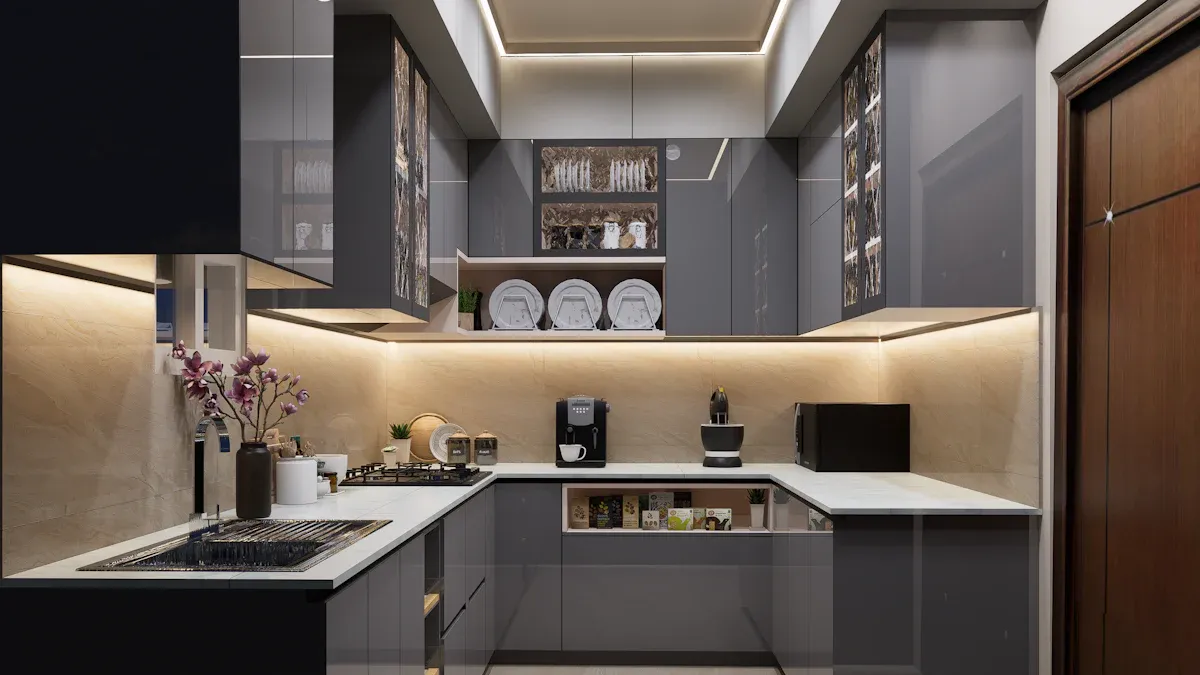
Modern Kitchen Renovation Example
When I remodeled my kitchen, I wanted everything to look sharp and work well. I chose LED under cabinet lights because they fit right into my new cabinets. The slim LED strips gave my counters a bright, even glow. I could pick warm or cool white, so I matched the light to my kitchen’s style. I liked that the lights had dimming and smart controls. I could set the mood for dinner or turn up the brightness for cooking. The fixtures felt sturdy, made from aluminum, and the IP rating meant I didn’t worry about splashes. The lights made my backsplash and countertops pop, and I noticed fewer shadows when chopping veggies.
- Energy savings and long lifespan lowered my bills.
- Easy installation with adhesive backing.
- No glare or hot spots thanks to high-density strips and diffusers.
The right under cabinet light made my kitchen both beautiful and practical.
Budget-Friendly Kitchen Upgrade
I wanted to brighten my old kitchen without spending a lot. I picked battery-powered LED strips. They stuck under my cabinets with adhesive and took just minutes to install. I didn’t need an electrician. The light made my counters easier to use, and I could change the color temperature for a cozy or bright look. Even with a small budget, my kitchen felt new.
High-Use Family Kitchen
My kitchen gets busy. I cook, my kids do homework, and we all gather there. I needed lighting that kept up. LED under cabinet lights gave me focused, shadow-free light for every task. I liked the adjustable brightness and motion sensors. The LEDs stayed cool, so I never worried about little hands getting burned. The lights lasted for years, and I saved money on energy. My kitchen felt safer, brighter, and more welcoming.
After trying both, I always recommend LED under cabinet light for kitchens. Experts and consumer reports agree LEDs shine brighter, last longer, and save money over time.
| Feature | LED Under-Cabinet Lights | Traditional Incandescent Bulbs |
|---|---|---|
| Energy Consumption | 75% less | Higher |
| Longevity | 25x longer | Shorter |
| Long-term Savings | Significant | Higher costs |
| Aesthetic Options | Many | Limited |
Lighting pros suggest picking LEDs for energy efficiency, style, and safety. I love the flexibility and modern look they bring to any kitchen.
FAQ
How do I clean LED under cabinet lights?
I wipe my LED lights with a soft, damp cloth. I avoid harsh cleaners. I unplug the lights first to stay safe.
Can I dim LED under cabinet lights?
Yes, I use a compatible LED dimmer switch. This lets me adjust the brightness for cooking or setting the mood.
Do LED under cabinet lights work in older kitchens?
Absolutely! I installed LED strips in my older cabinets. The adhesive backing made it easy. No need for special wiring or tools.
Post time: Jul-14-2025






